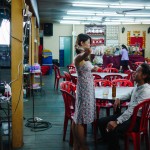Directed by Ming Jin Woo
International Film Festival Rotterdam review
From its pensive opening minutes to its quiet revelation of a conclusion, the present day Malaysia of Ming Jin Woo’s The Second Life of Thieves exists as a consistently lonely aftermath to a more passionate, even violent past. From the recent murder of a Burmese girl to the still stinging memories of an affair ended decades prior, most of the film’s non-linear narrative involves the piecing together of a mysterious and sorrowful past. Delivered with gentle, lo-fi aesthetics, Jin Woo’s film is a search for truth that connects the past to the present, the historical to the personal and reality to dreams in order to break through the whitewashed narratives of where we are and how we got here.
Wandering through the open, placid landscape of the present day is village chief Tan, a reticent character investigating the aforementioned death as well as the disappearances of both his wife and his best friend Lai. The latter of these two situations brings Tan into contact with Lai’s grown up daughter Sandy, who tenderly delivers an account of her father’s past affair with Tan’s wife that’s part first-hand and part second-hand. The other shoe doesn’t drop until the film’s second half when a more accurate version of events comes to light that highlights Malaysia’s upsetting track record when it comes to gay rights.

With its low contrast colour palette and minimalist piano accompaniment, The Second Life of Thieves is a drama executed with the lightest of touches, more concerned with conveying long lingering aches than emotional gut punches. The delicate editing blurs the lines between different places, periods, perceptions and states of being to create a reality built on wandering thoughts and subjectivity. At times, this approach can hinder the naturalism of the film’s narrative progression, denying some individual scenes sufficient breathing space, and the understated style and tangential structure can sometimes come across as simply non-committal (audiences would be forgiven for fidgeting a little in their seats during the final half hour) but, when all the elements of the film click into place, a subtle poetry emerges that resonates beyond the sum of the film’s images and dialogue.
It seems appropriate that the warmest section of the feature is found in Tan’s (relatively) truthful recollection of the forbidden romance from many years ago. If there is optimism to be found in The Second Life of Thieves, it is in knowing that happiness can come in these isolated moments, however fleeting. But, as the film makes clear, history has a sad tendency to bury or rewrite itself at the convenience of current and past prejudice and corruption. Ming Jin Woo’s flawed but affecting picture seeks to undo some of this damage, giving voice to stories, thoughts and feelings that were forced to remain unspoken.
Watch The Second Life of Thieves on FilmDoo.com.
Recommended Viewing on FilmDoo:
(UK & Ireland only)








